1997 MERCEDES-BENZ ML320 engine
[x] Cancel search: enginePage 3148 of 4133
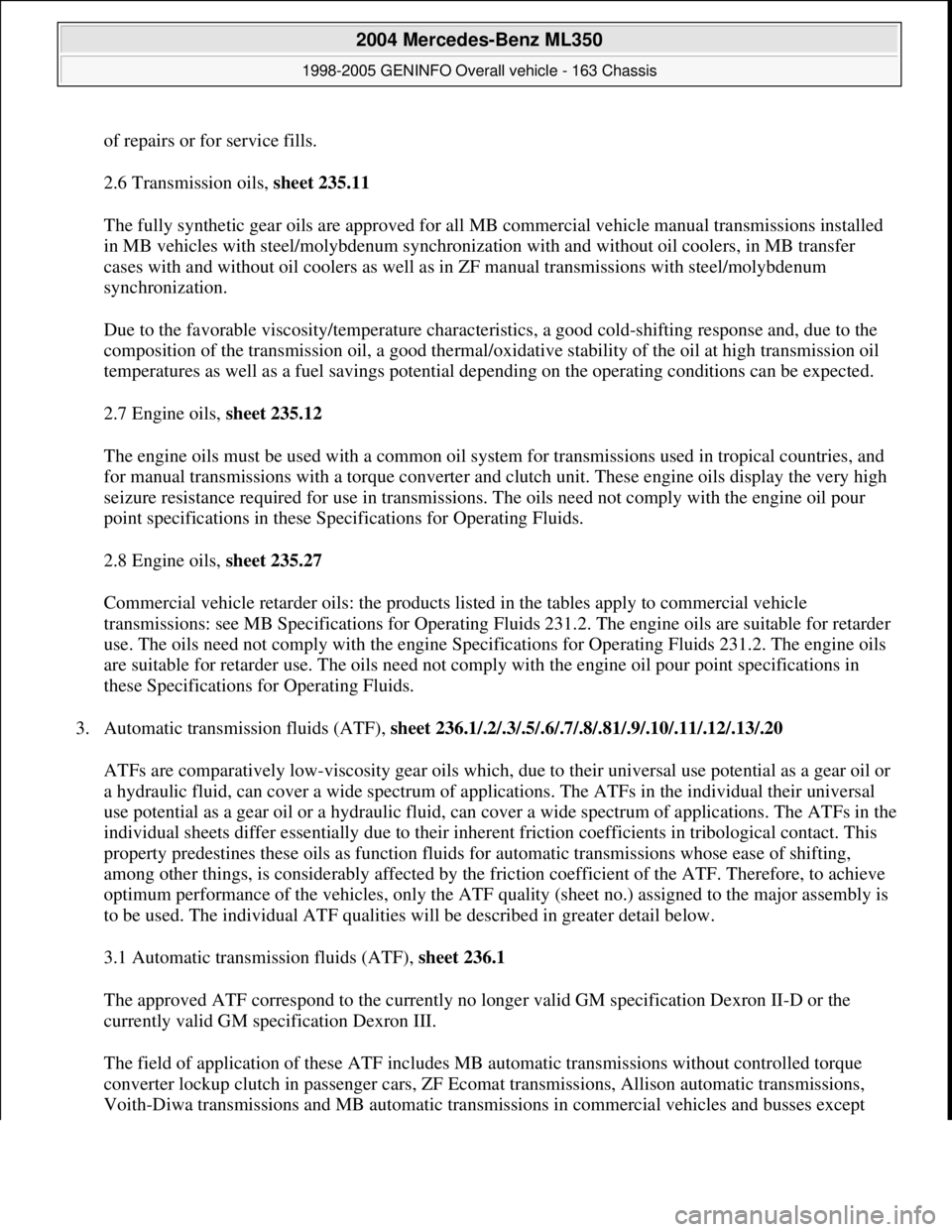
of repairs or for service fills.
2.6 Transmission oils, sheet 235.11
The fully synthetic gear oils are approved for all MB commercial vehicle manual transmissions installed
in MB vehicles with steel/molybdenum synchronization with and without oil coolers, in MB transfer
cases with and without oil coolers as well as in ZF manual transmissions with steel/molybdenum
synchronization.
Due to the favorable viscosity/temperature characteristics, a good cold-shifting response and, due to the
composition of the transmission oil, a good thermal/oxidative stability of the oil at high transmission oil
temperatures as well as a fuel savings potential depending on the operating conditions can be expected.
2.7 Engine oils, sheet 235.12
The engine oils must be used with a common oil system for transmissions used in tropical countries, and
for manual transmissions with a torque converter and clutch unit. These engine oils display the very high
seizure resistance required for use in transmissions. The oils need not comply with the engine oil pour
point specifications in these Specifications for Operating Fluids.
2.8 Engine oils, sheet 235.27
Commercial vehicle retarder oils: the products listed in the tables apply to commercial vehicle
transmissions: see MB Specifications for Operating Fluids 231.2. The engine oils are suitable for retarder
use. The oils need not comply with the engine Specifications for Operating Fluids 231.2. The engine oils
are suitable for retarder use. The oils need not comply with the engine oil pour point specifications in
these Specifications for Operating Fluids.
3. Automatic transmission fluids (ATF), sheet 236.1/.2/.3/.5/.6/.7/.8/.81/.9/.10/.11/.12/.13/.20
ATFs are comparatively low-viscosity gear oils which, due to their universal use potential as a gear oil or
a hydraulic fluid, can cover a wide spectrum of applications. The ATFs in the individual their universal
use potential as a gear oil or a hydraulic fluid, can cover a wide spectrum of applications. The ATFs in the
individual sheets differ essentially due to their inherent friction coefficients in tribological contact. This
property predestines these oils as function fluids for automatic transmissions whose ease of shifting,
among other things, is considerably affected by the friction coefficient of the ATF. Therefore, to achieve
optimum performance of the vehicles, only the ATF quality (sheet no.) assigned to the major assembly is
to be used. The individual ATF qualities will be described in greater detail below.
3.1 Automatic transmission fluids (ATF), sheet 236.1
The approved ATF correspond to the currently no longer valid GM specification Dexron II-D or the
currently valid GM specification Dexron III.
The field of application of these ATF includes MB automatic transmissions without controlled torque
converter lockup clutch in passenger cars, ZF Ecomat transmissions, Allison automatic transmissions,
Voith-Diwa transmissions and MB automatic transmissions in commercial vehicles and busses except
2004 Mercedes-Benz ML350
1998-2005 GENINFO Overall vehicle - 163 Chassis
me
Saturday, October 02, 2010 3:47:56 PMPage 503 © 2006 Mitchell Repair Information Company, LLC.
Page 3149 of 4133
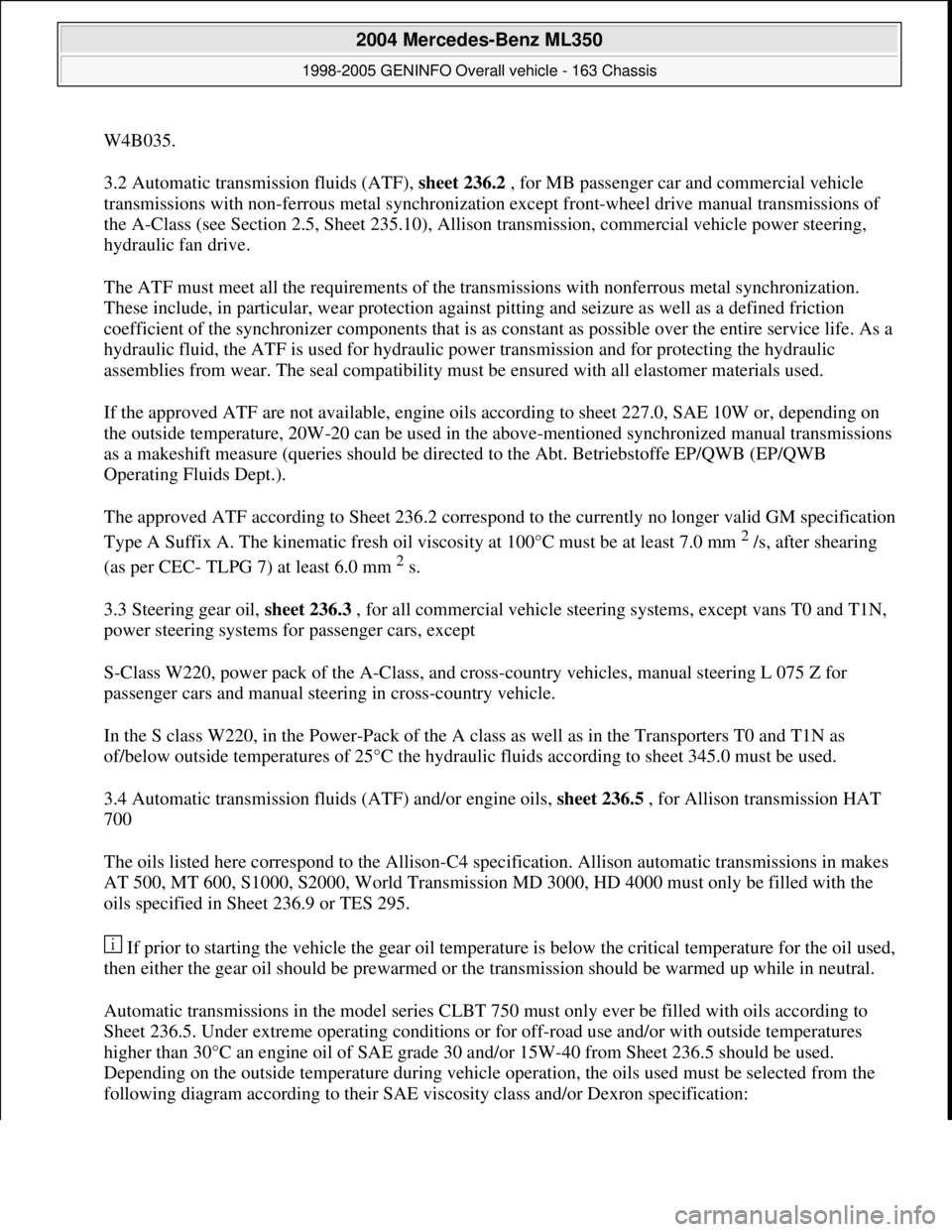
W4B035.
3.2 Automatic transmission fluids (ATF), sheet 236.2 , for MB passenger car and commercial vehicle
transmissions with non-ferrous metal synchronization except front-wheel drive manual transmissions of
the A-Class (see Section 2.5, Sheet 235.10), Allison transmission, commercial vehicle power steering,
hydraulic fan drive.
The ATF must meet all the requirements of the transmissions with nonferrous metal synchronization.
These include, in particular, wear protection against pitting and seizure as well as a defined friction
coefficient of the synchronizer components that is as constant as possible over the entire service life. As a
hydraulic fluid, the ATF is used for hydraulic power transmission and for protecting the hydraulic
assemblies from wear. The seal compatibility must be ensured with all elastomer materials used.
If the approved ATF are not available, engine oils according to sheet 227.0, SAE 10W or, depending on
the outside temperature, 20W-20 can be used in the above-mentioned synchronized manual transmissions
as a makeshift measure (queries should be directed to the Abt. Betriebstoffe EP/QWB (EP/QWB
Operating Fluids Dept.).
The approved ATF according to Sheet 236.2 correspond to the currently no longer valid GM specification
Type A Suffix A. The kinematic fresh oil viscosity at 100°C must be at least 7.0 mm
2 /s, after shearing
(as per CEC- TLPG 7) at least 6.0 mm
2 s.
3.3 Steering gear oil, sheet 236.3 , for all commercial vehicle steering systems, except vans T0 and T1N,
power steering systems for passenger cars, except
S-Class W220, power pack of the A-Class, and cross-country vehicles, manual steering L 075 Z for
passenger cars and manual steering in cross-country vehicle.
In the S class W220, in the Power-Pack of the A class as well as in the Transporters T0 and T1N as
of/below outside temperatures of 25°C the hydraulic fluids according to sheet 345.0 must be used.
3.4 Automatic transmission fluids (ATF) and/or engine oils, sheet 236.5 , for Allison transmission HAT
700
The oils listed here correspond to the Allison-C4 specification. Allison automatic transmissions in makes
AT 500, MT 600, S1000, S2000, World Transmission MD 3000, HD 4000 must only be filled with the
oils specified in Sheet 236.9 or TES 295.
If prior to starting the vehicle the gear oil temperature is below the critical temperature for the oil used,
then either the gear oil should be prewarmed or the transmission should be warmed up while in neutral.
Automatic transmissions in the model series CLBT 750 must only ever be filled with oils according to
Sheet 236.5. Under extreme operating conditions or for off-road use and/or with outside temperatures
higher than 30°C an engine oil of SAE grade 30 and/or 15W-40 from Sheet 236.5 should be used.
Depending on the outside temperature during vehicle operation, the oils used must be selected from the
followin
g diagram according to their SAE viscosity class and/or Dexron specification:
2004 Mercedes-Benz ML350
1998-2005 GENINFO Overall vehicle - 163 Chassis
me
Saturday, October 02, 2010 3:47:56 PMPage 504 © 2006 Mitchell Repair Information Company, LLC.
Page 3158 of 4133
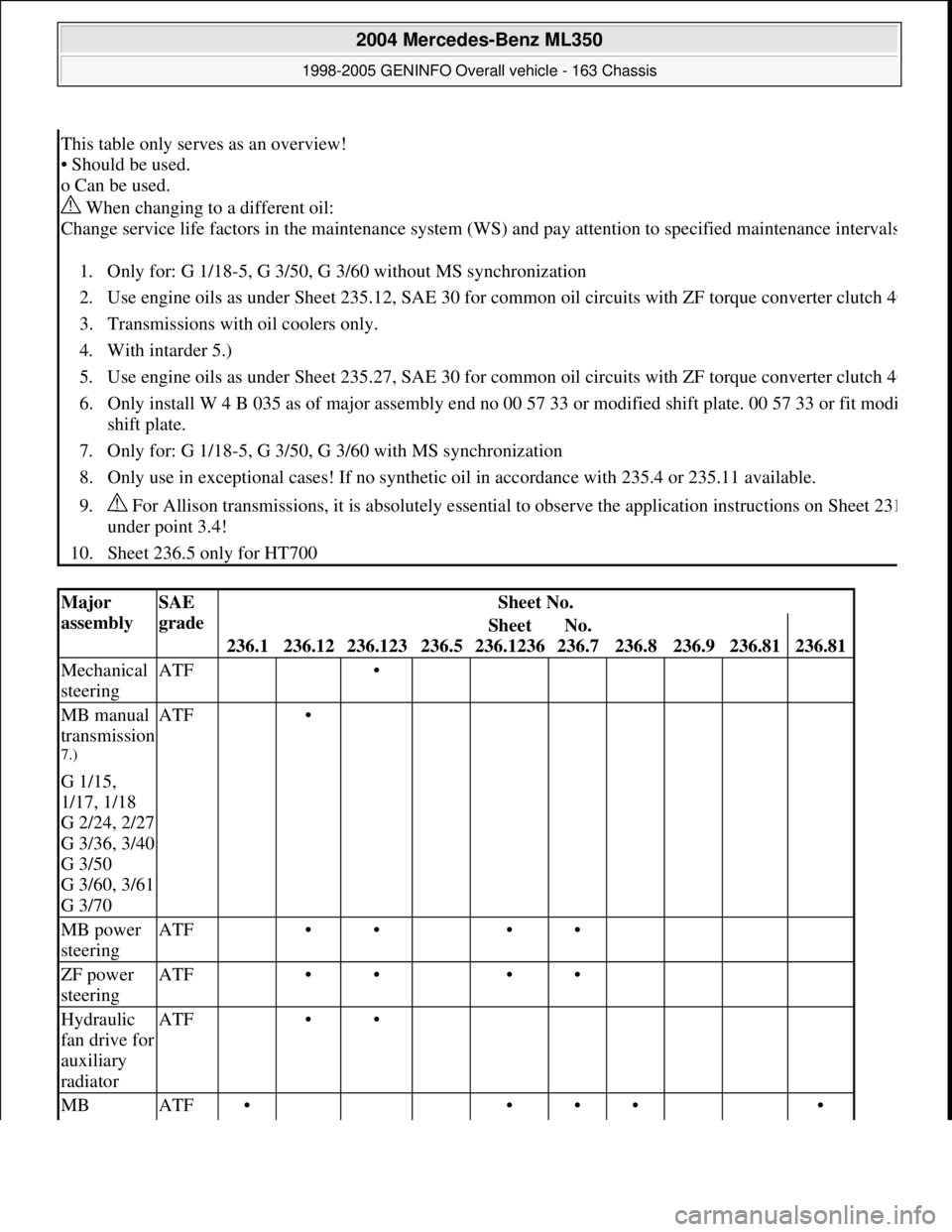
This table only serves as an overview!
• Should be used.
o Can be used.
When changing to a different oil:
Change service life factors in the maintenance system (WS) and pay attention to specified maintenance interval
s
1. Only for: G 1/18-5, G 3/50, G 3/60 without MS synchronization
2. Use engine oils as under Sheet 235.12, SAE 30 for common oil circuits with ZF torque converter clutch 4
0
3. Transmissions with oil coolers only.
4. With intarder 5.)
5. Use engine oils as under Sheet 235.27, SAE 30 for common oil circuits with ZF torque converter clutch 4
0
6. Only install W 4 B 035 as of major assembly end no 00 57 33 or modified shift plate. 00 57 33 or fit modi
shift plate.
7. Only for: G 1/18-5, G 3/50, G 3/60 with MS synchronization
8. Only use in exceptional cases! If no synthetic oil in accordance with 235.4 or 235.11 available.
9. For Allison transmissions, it is absolutely essential to observe the application instructions on Sheet 23
1
under point 3.4!
10. Sheet 236.5 only for HT700
Major
assemblySAE
gradeSheet No.
236.1236.12236.123236.5
Sheet
236.1236No.
236.7
236.8236.9236.81236.81
Mechanical
steeringATF •
MB manual
transmission
7.)
G 1/15,
1/17, 1/18
G 2/24, 2/27
G 3/36, 3/40
G 3/50
G 3/60, 3/61
G 3/70
ATF •
MB power
steeringATF •• ••
ZF power
steeringATF •• ••
Hydraulic
fan drive for
auxiliary
radiatorATF ••
MB ATF• ••• •
2004 Mercedes-Benz ML350
1998-2005 GENINFO Overall vehicle - 163 Chassis
me
Saturday, October 02, 2010 3:47:56 PMPage 513 © 2006 Mitchell Repair Information Company, LLC.
Page 3159 of 4133
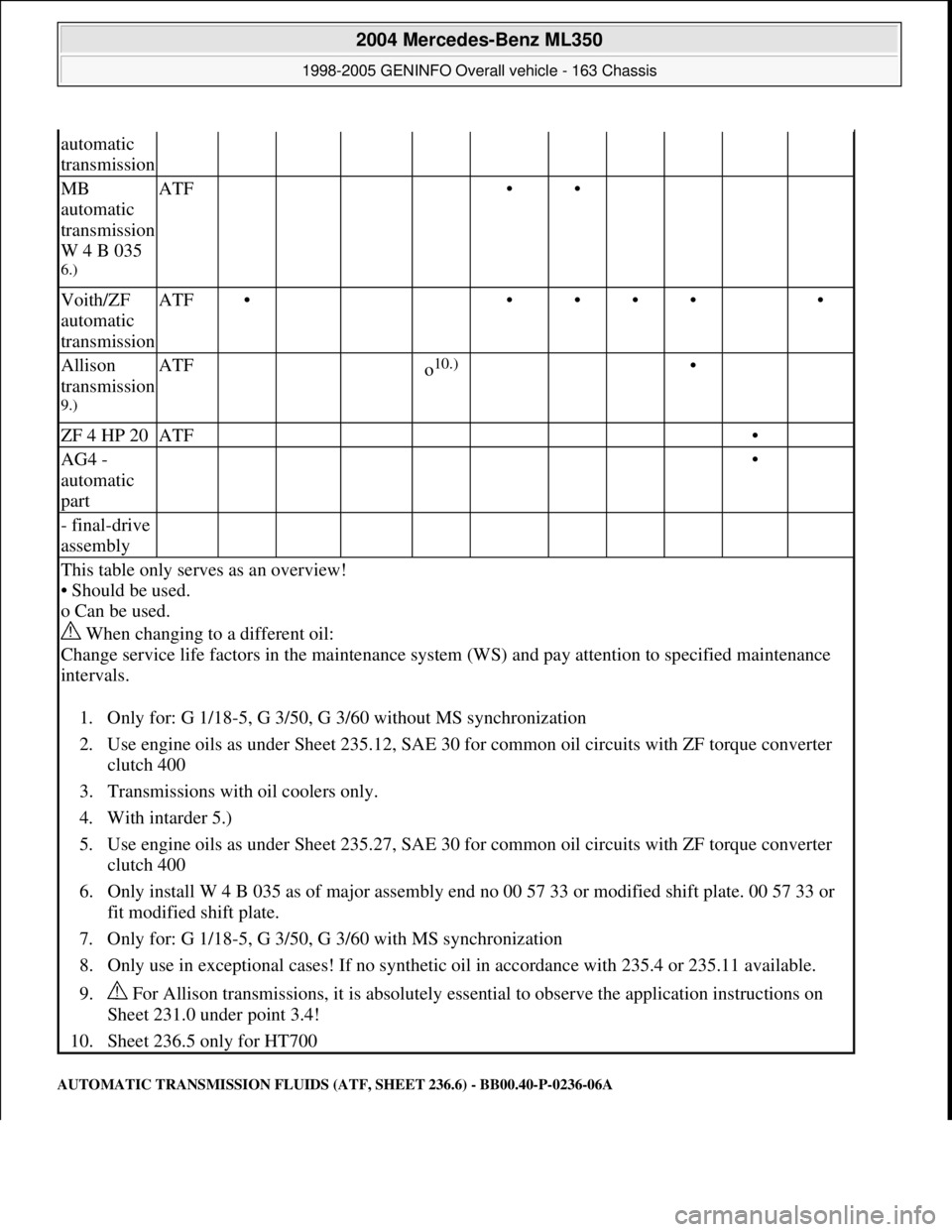
AUTOMATIC TRANSMISSION FLUIDS (ATF, SHEET 236.6) - BB00.40-P-0236-06A
automatic
transmission
MB
automatic
transmission
W 4 B 035
6.)
ATF ••
Voith/ZF
automatic
transmissionATF• •••• •
Allison
transmission
9.)
ATF o10.) •
ZF 4 HP 20ATF •
AG4 -
automatic
part •
- final-drive
assembly
This table only serves as an overview!
• Should be used.
o Can be used.
When changing to a different oil:
Change service life factors in the maintenance system (WS) and pay attention to specified maintenance
intervals.
1. Only for: G 1/18-5, G 3/50, G 3/60 without MS synchronization
2. Use engine oils as under Sheet 235.12, SAE 30 for common oil circuits with ZF torque converter
clutch 400
3. Transmissions with oil coolers only.
4. With intarder 5.)
5. Use engine oils as under Sheet 235.27, SAE 30 for common oil circuits with ZF torque converter
clutch 400
6. Only install W 4 B 035 as of major assembly end no 00 57 33 or modified shift plate. 00 57 33 or
fit modified shift plate.
7. Only for: G 1/18-5, G 3/50, G 3/60 with MS synchronization
8. Only use in exceptional cases! If no synthetic oil in accordance with 235.4 or 235.11 available.
9. For Allison transmissions, it is absolutely essential to observe the application instructions on
Sheet 231.0 under point 3.4!
10. Sheet 236.5 only for HT700
2004 Mercedes-Benz ML350
1998-2005 GENINFO Overall vehicle - 163 Chassis
me
Saturday, October 02, 2010 3:47:56 PMPage 514 © 2006 Mitchell Repair Information Company, LLC.
Page 3165 of 4133

COOLANT SPECIFICATIONS - BB00.40-P-0310-01A
1.Coolant
1.1 Coolant composition
1.1.1 Passenger car and commercial vehicle engines (normal case)
50 vol.-% Water
50 vol.-% Anticorrosion/antifreeze agents (see Sheet 325.0 or 325.2, 325.3) antifreeze protection down to
approx. -37°C
Pre-mixed products in accordance with sheets 326.x can also be used.
1.1.2 Commercial vehicle engines (without antifreeze specification)
Blend of water and coolant additive in accordance with Sheet 312.0, for prescribed mixture ratio refer to
Sheet 312.0.
Germany
Navigan Multipurpose Grease HL 2Oelwerke Julius Schindler GmbH, Hamburg,
Germany
Oest Mehrzweckfett GOC 190Georg Oest Mineralolwerk GmbH & Co KG,
Freudenstadt/Germany
Optimol Olit 2 EPCastrol Industrie GmbH, Monchengladbach,
Germany
Ravenol multipurpose grease OMLRavensberger Schmierstoffvertrieb GmbH, Werther,
Germany
Renolit MPFuchs Petrolub AG, Mannheim, Germany
Rhenus Norlith KSP 2Rhenus Lub. GmbH & Co KG, Monchengladbach,
Germany
Rhenus Norlith MZK 2Rhenus Lub. GmbH & Co KG, Monchengladbach,
Germany
Rhenus Norlith MZN 2Rhenus Lub. GmbH & Co KG, Monchengladbach,
Germany
Shell Retinax EPL2Shell International Petroleum Co., London, England
Texaco Multifak B EP 2ChevronTexaco Technology Ghent,
Ghent/Zwijnaarde, Belgium
Texaco Multifak EP 2ChevronTexaco Technology Ghent,
Ghent/Zwijnaarde, Belgium
Wintershall Wiolub LFK 2SRS SchmierstoffVertrieb GmbH, Salzbergen,
Germany
NOTE: These regulations apply to the Mercedes-Benz, Maybach and smart brands.
2004 Mercedes-Benz ML350
1998-2005 GENINFO Overall vehicle - 163 Chassis
me
Saturday, October 02, 2010 3:47:57 PMPage 520 © 2006 Mitchell Repair Information Company, LLC.
Page 3166 of 4133
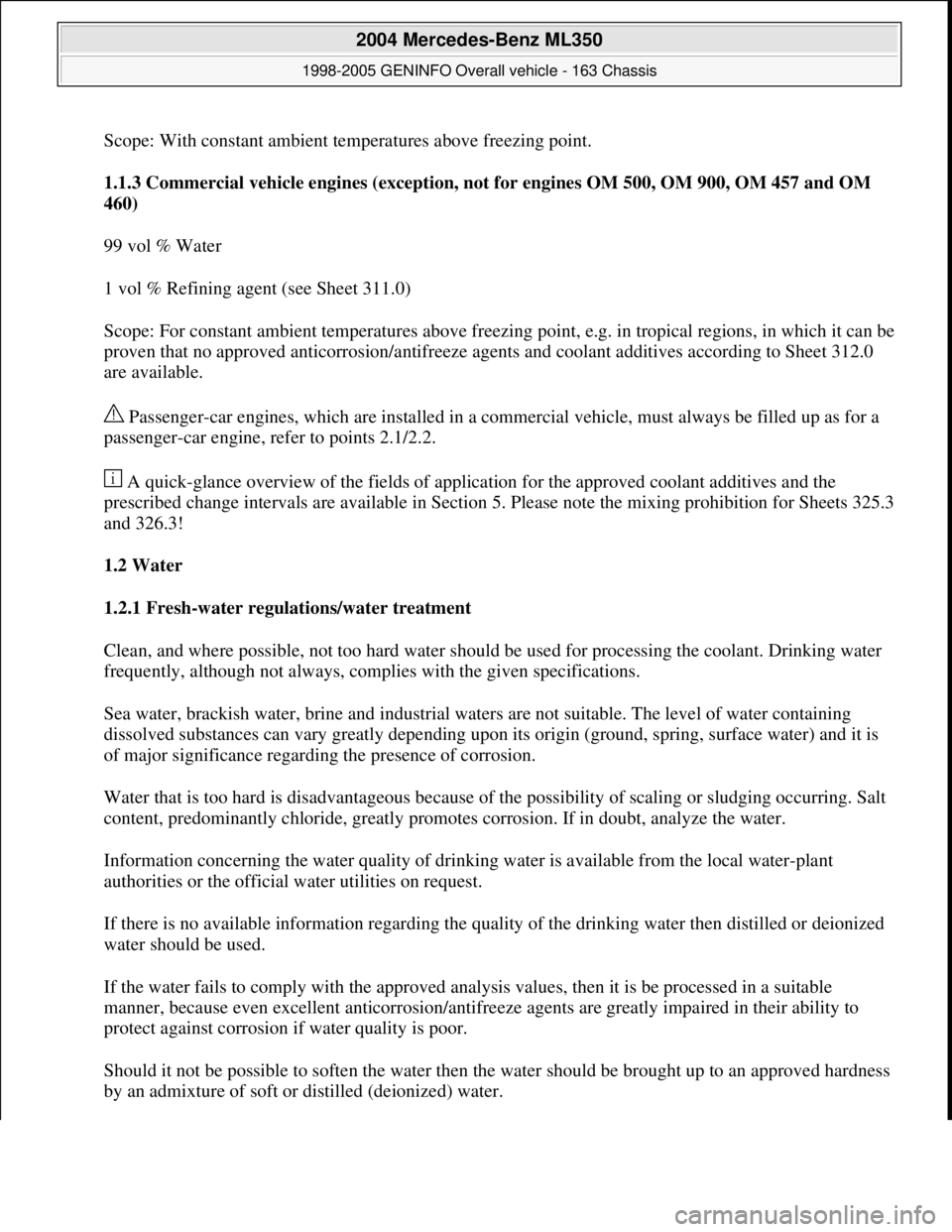
Scope: With constant ambient temperatures above freezing point.
1.1.3 Commercial vehicle engines (exception, not for engines OM 500, OM 900, OM 457 and OM
460)
99 vol % Water
1 vol % Refining agent (see Sheet 311.0)
Scope: For constant ambient temperatures above freezing point, e.g. in tropical regions, in which it can be
proven that no approved anticorrosion/antifreeze agents and coolant additives according to Sheet 312.0
are available.
Passenger-car engines, which are installed in a commercial vehicle, must always be filled up as for a
passenger-car engine, refer to points 2.1/2.2.
A quick-glance overview of the fields of application for the approved coolant additives and the
prescribed change intervals are available in Section 5. Please note the mixing prohibition for Sheets 325.3
and 326.3!
1.2 Water
1.2.1 Fresh-water regulations/water treatment
Clean, and where possible, not too hard water should be used for processing the coolant. Drinking water
frequently, although not always, complies with the given specifications.
Sea water, brackish water, brine and industrial waters are not suitable. The level of water containing
dissolved substances can vary greatly depending upon its origin (ground, spring, surface water) and it is
of major significance regarding the presence of corrosion.
Water that is too hard is disadvantageous because of the possibility of scaling or sludging occurring. Salt
content, predominantly chloride, greatly promotes corrosion. If in doubt, analyze the water.
Information concerning the water quality of drinking water is available from the local water-plant
authorities or the official water utilities on request.
If there is no available information regarding the quality of the drinking water then distilled or deionized
water should be used.
If the water fails to comply with the approved analysis values, then it is be processed in a suitable
manner, because even excellent anticorrosion/antifreeze agents are greatly impaired in their ability to
protect against corrosion if water quality is poor.
Should it not be possible to soften the water then the water should be brought up to an approved hardness
by an admixture of soft or distilled (deionized) water.
2004 Mercedes-Benz ML350
1998-2005 GENINFO Overall vehicle - 163 Chassis
me
Saturday, October 02, 2010 3:47:57 PMPage 521 © 2006 Mitchell Repair Information Company, LLC.
Page 3167 of 4133
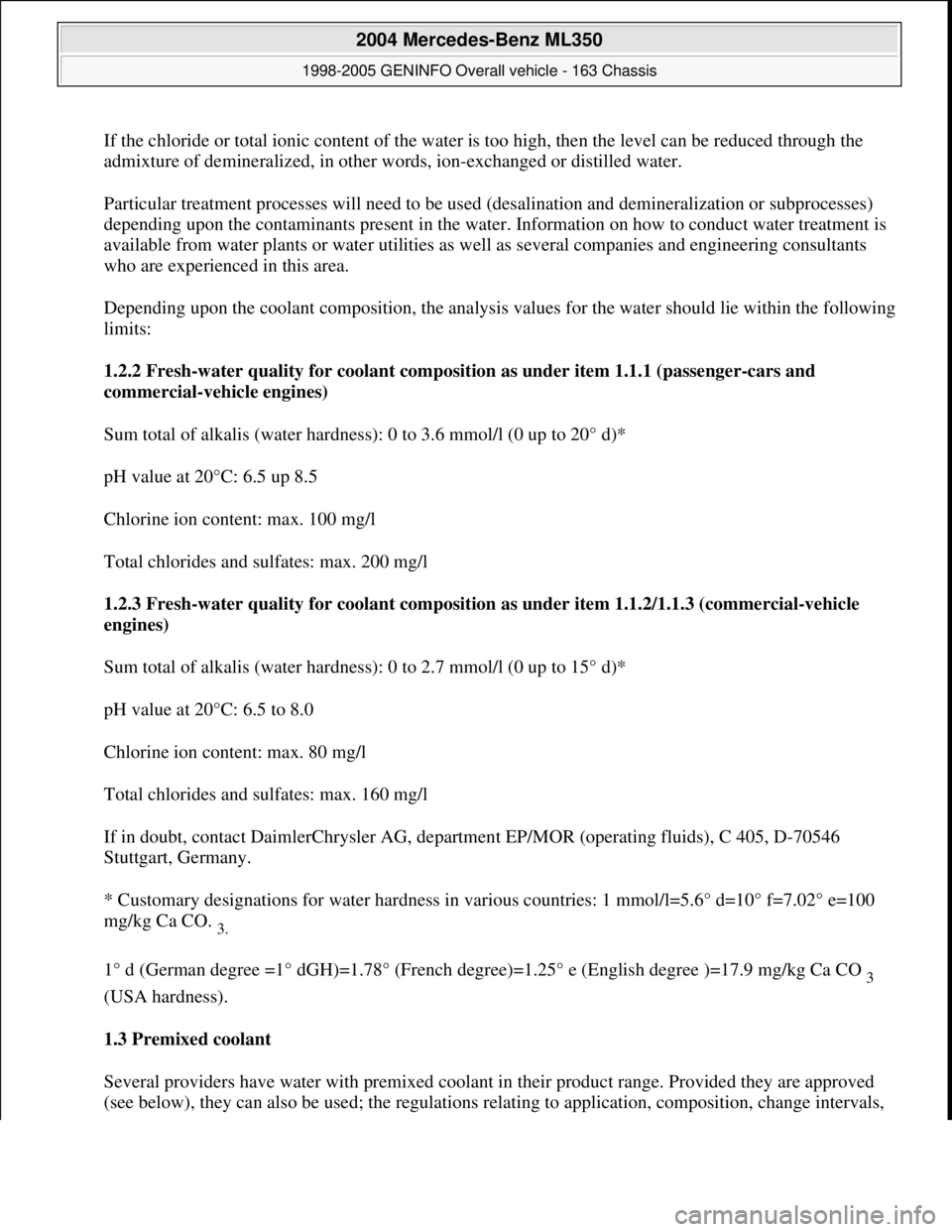
If the chloride or total ionic content of the water is too high, then the level can be reduced through the
admixture of demineralized, in other words, ion-exchanged or distilled water.
Particular treatment processes will need to be used (desalination and demineralization or subprocesses)
depending upon the contaminants present in the water. Information on how to conduct water treatment is
available from water plants or water utilities as well as several companies and engineering consultants
who are experienced in this area.
Depending upon the coolant composition, the analysis values for the water should lie within the following
limits:
1.2.2 Fresh-water quality for coolant composition as under item 1.1.1 (passenger-cars and
commercial-vehicle engines)
Sum total of alkalis (water hardness): 0 to 3.6 mmol/l (0 up to 20° d)*
pH value at 20°C: 6.5 up 8.5
Chlorine ion content: max. 100 mg/l
Total chlorides and sulfates: max. 200 mg/l
1.2.3 Fresh-water quality for coolant composition as under item 1.1.2/1.1.3 (commercial-vehicle
engines)
Sum total of alkalis (water hardness): 0 to 2.7 mmol/l (0 up to 15° d)*
pH value at 20°C: 6.5 to 8.0
Chlorine ion content: max. 80 mg/l
Total chlorides and sulfates: max. 160 mg/l
If in doubt, contact DaimlerChrysler AG, department EP/MOR (operating fluids), C 405, D-70546
Stuttgart, Germany.
* Customary designations for water hardness in various countries: 1 mmol/l=5.6° d=10° f=7.02° e=100
mg/kg Ca CO.
3.
1° d (German degree =1° dGH)=1.78° (French degree)=1.25° e (English degree )=17.9 mg/kg Ca CO
3
(USA hardness).
1.3 Premixed coolant
Several providers have water with premixed coolant in their product range. Provided they are approved
(see below), the
y can also be used; the regulations relating to application, composition, change intervals,
2004 Mercedes-Benz ML350
1998-2005 GENINFO Overall vehicle - 163 Chassis
me
Saturday, October 02, 2010 3:47:57 PMPage 522 © 2006 Mitchell Repair Information Company, LLC.
Page 3168 of 4133

etc. of these coolant specifications also apply. It is imperative that the correct concentration (50/50) is
used in their application and, of course, further dilution is not permitted!
Approval status:
Coolants for all vehicle and engines (Basis 325.0) Sheet 326.0
Coolants for commercial vehicle and industrial engines (Basis 325.2) Sheet 326.2
Coolants for commercial vehicle and industrial engines (Basis 325.3) Sheet 326.3
The regulations for each respective Sheet 325.x are to be transferred correspondingly to Sheet
326.x.
At the time of compiling these regulations it is possible that not all the Sheets 326.x are represented with
approved products.
2.Coolant additives (General information)
Normally, coolant consists of water and anticorrosion/antifreeze agents. The anticorrosion/antifreeze
agents (ethylene glycol with corrosions inhibitors) in the cooling system have to fulfill, among other
things, the following functions:
to provide sufficient corrosion and cavitation protection for all cooling system components
freezing point depression (antifreeze)
increasing boiling point
For corrosion protection purposes the coolant
approx. 50 vol.-% Anticorrosion/antifreeze agents are added if the expected ambient temperatures do not
require an even higher concentration. This concentration (50 vol %) offers frost protection up to approx. -
37°C. A higher concentration is only necessary if the ambient temperatures are even lower.
Even with extremely low ambient temperatures, not more than 55 vol.-% anticorrosion/antifreeze agent
should be used, because at this level the maximum antifreeze protection is reached and a greater
concentration reduces the antifreeze protection again and decreases the heat dissipation (55 vol.-%
corresponds to antifreeze protection down to approx. -45°C).
Should these coolant regulations fail to be observed then corrosion and damage to the cooling
system are inevitable.
The admixture of anticorrosion/antifreeze agent serves to increase the boiling point. By raising the
pressure the boiling temperature can be increased yet further. Both physical relationships are put to use in
modern cooling systems - the maximum coolant temperature is raised, without increasing the danger of
boiling. In keeping with the higher temperature level the cooling performance is also greater. Only
approved products (Sheet 325.0/326.0 or 325.2 or 326.2, 325.3 or 326.3 as well as 312.0 or 311.0)
2004 Mercedes-Benz ML350
1998-2005 GENINFO Overall vehicle - 163 Chassis
me
Saturday, October 02, 2010 3:47:57 PMPage 523 © 2006 Mitchell Repair Information Company, LLC.